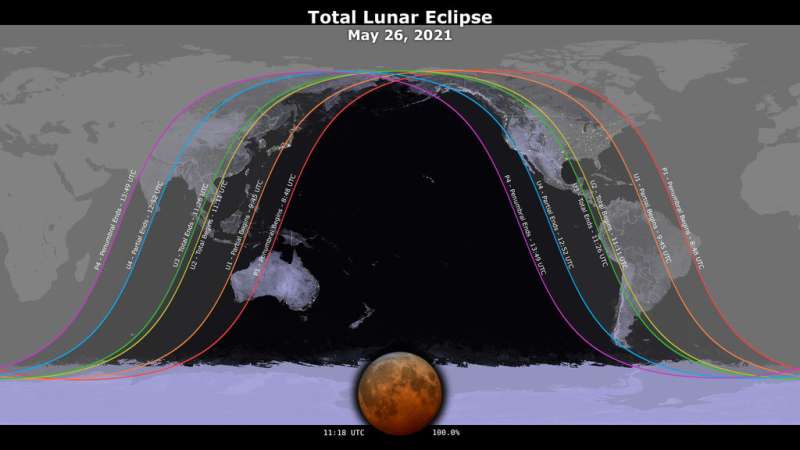This month brings the "most super" of the year's supermoons, and on top of that, a total lunar eclipse. In other words, on May 26, 2021, the full moon will enter Earth's shadow—and, when the moon is not in our planet's shade, it will appear even bigger and brighter than usual.
What is a supermoon?
The moon travels around our planet in an elliptical orbit, or an elongated circle. Each month, the moon passes through perigee (the point closest to Earth) and apogee (the point farthest from Earth). When the moon is at or near its closest point to Earth at the same time as it is full, it is called a "supermoon." During this event, because the full moon is a little bit closer to us than usual, it appears especially large and bright in the sky.
What is a lunar eclipse?
A lunar eclipse takes place when the sun and moon occupy precise positions on opposite sides of Earth. During this alignment, Earth blocks some of the sun's light from reaching the full moon. Our atmosphere filters the light as it passes, softening the edge of our planet's shadow and giving the moon a deep, rosy glow.
How can I see the supermoon eclipse?
Observers all over the world will be able to see the supermoon throughout the night if the sky is clear. Like all full moons, the supermoon rises in the east around sunset and sets in the west around sunrise. It is highest overhead in the late night and very early morning hours.
The lunar eclipse is harder to catch. The total eclipse, or the time when the moon is in deepest shadow, will last for about 15 minutes. If the moon is up in your area while this happens, you are in for a treat.
he total lunar eclipse will be visible near moonset in the western continental United States and Canada, all of Mexico, most of Central America and Ecuador, western Peru, and southern Chile and Argentina. Along the Asian Pacific Rim, the total eclipse will be visible just after moonrise.
The partial eclipse, which takes place as the moon moves into and out of Earth's shadow, will be visible from the eastern United States and Canada just before the moon sets in the morning, and from India, Nepal, western China, Mongolia, and eastern Russia just after the moon rises in the evening.
Observers in eastern Australia, New Zealand, and the Pacific Islands, including Hawaii, will see both the total and the partial eclipse.
If the supermoon eclipse isn't visible from your location, you can still explore this phenomenon second by second with NASA's Scientific Visualization Studio.
Why does the moon turn red during a lunar eclipse?
Colors are one way for our brains to interpret variations in the physical properties of light. These same properties cause each color of light to behave differently when passing through a substance like air. If you've ever looked up at a blue sky, or savored a fiery sunset, you have seen this phenomenon in action.
Sunlight bends and scatters as it passes through Earth's atmosphere. In air, colors at the blue and violet end of the rainbow scatter more widely than colors like red and orange. Widely scattered blue light tints the sky when the sun is overhead on clear days. Redder light travels a straighter path through the air; we only see it scattered throughout the sky around sunrise and sunset, when sunlight has traveled through a thick slice of Earth's atmosphere before reaching our eyes.
During a lunar eclipse, some of this heavily filtered morning and evening light makes it all the way through Earth's atmosphere and eventually reaches the lunar surface. The eclipsed moon is dimly illuminated by red-orange light left over from all of the sunsets and sunrises occurring around the world at that time. The more dust or clouds in Earth's atmosphere during the eclipse, the redder the moon will appear.
Are all supermoons red? Are all lunar eclipses supermoons?
No, and no. Supermoons and lunar eclipses are different phenomena that do not always occur at the same time. This month brings an excellent opportunity to enjoy the view.
Explore further



